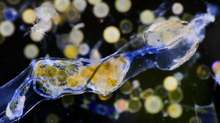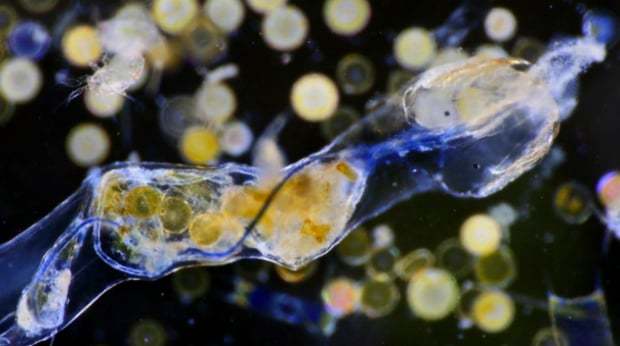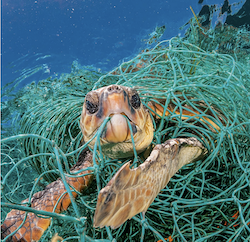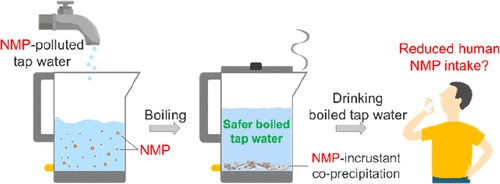How to Reduce Microplastics in Your Water

To reduce microplastics everywhere should be our objective, because they are everywhere and in everything tested. Take the first step and reduce microplastics in your water!

Updated on March 16, 2024
To reduce microplastics in your water, food and body is becoming a central focus of governments and scientists around the world. The reason is that these tiny particles of plastics are found everywhere — down to the cellular level on our bodies — and we have no idea of the long-term damage they may cause.
In this post, I will:
- Describe the current situation with microplastics,
- Why you should care about their ubiquity, and
- What you can do to reduce microplastics in your water.
Let’s dig in…
What’s Up with Microplastics
Our world is polluted by trillions of bits of plastic. Inevitably, what pollutes our world, such as DDT in the past and various pesticides and chemicals currently, what pollutes our world eventually winds up polluting us.
While we know the damage that pesticides, chemicals, heavy metals and their ilk do to our bodies, we don’t know what may be the deleterious effects of these plastic bits, referred to as either microplastics or nanoplastics, depending on their size (nano is smaller than micro).
This is in stark contrast to what we do know about the various toxins that proliferate across the planet, as I wrote about in How 212 Toxins In Your Body Make You Sick and Fat.
What we do know is that micro/nano plastics are found everywhere:
- Human body:
- Blood: A 2023 study published in Environment International found microplastics in the blood of 80% of healthy individuals tested [1].
- Arteries: As reviewed in the New England Journal of Medicine, medical researchers in Italy found that nearly 60% of patients that had fatty deposits surgically removed from their arteries had measurable amounts of polyethylene in plaques, and 12% also had polyvinyl chloride (PVC) in extracted fat deposits. Note: these are significantly larger than nano and microplastics. (UPDATE: See Dr. Brad Stanfield’s video below, which includes his strategy for avoiding these plastics.)
- Lungs: Microplastics have been found in human lung tissue, suggesting inhalation as a possible route of entry [2].
- Placenta: A 2020 study published in Archives of Environmental Contamination and Toxicology detected microplastics in the placentas of women who had recently given birth [3].
- Environment:
- Oceans: Microplastics are widespread in the marine environment, with studies finding them in everything from plankton to large fish [4].
- Freshwater: Microplastics have been found in freshwater sources like rivers, lakes, and even drinking water [5].
- Soil: Microplastics are increasingly being found in soil, likely due to factors like sewage sludge application and plastic mulch [6].
- Air: Microplastics can be present in the air we breathe, originating from sources like car tire wear and textile shedding [7].
- Food: Microplastics have been found in a variety of food items, including bottled water, shellfish, and even table salt [8].
Clearly, these tiny pits of plastic are everywhere, but are they doing any damage?
Are Micro/Nano Plastics Harmful?
We don’t know yet.
Differentiating the effects of microplastics from other contaminants can be challenging. 
Of course, the damage that larger pieces of plastic do to the environment and wildlife is obvious, but scientists have yet to establish a cause and effect relationship between the tiny bits and animal health, including ours.
Scientists are actively researching the potential harm of nano and microplastics in animals and humans, using various approaches, For instance, scientists are using in vitro (cell cultures) and in vivo (animal models) studies to assess the potential harms of ingested, inhaled, or injected microplastics. These studies investigate potential effects on various organs and systems, like inflammation, oxidative stress, and organ damage, but definitive conclusions directly applicable to humans have not been established.
 If, however, you’re a fat-eating mouse, you may be in danger!
If, however, you’re a fat-eating mouse, you may be in danger!
A 2023 study that examined the effects of microplastics on mice fed a high fat diet concluded that “MP [microplastics] induced metabolic disturbances, such as diabetes and NAFLD [nonalcoholic fatty liver disease], only in mice fed a high-fat diet. These findings suggest that LGS [leaky gut syndrome] might have been triggered by HFD [high-fat diet], causing MPs [microplastics] to be deposited in the intestinal mucosa, resulting in inflammation of the intestinal mucosal intrinsic layer and thereby altering nutrient absorption.”
Apparently, at least with mice, a high-fat diet can result in inflammation of the intestinal mucosal layer () and thereby alter the absorption of nutrients.
OK, that said, this doesn’t seem to be something to make your hair go on fire over concerns about ingesting micro/nano particles.
The thing is, we just don’t know.
So, what can you do to be on the safe side?
Reduce Microplastics In Your Water

One thing you can do is to reduce microplastics in your water. I’m following the science on this by boiling the water I drink, starting today. The video below describes the new studies about the effectiveness of boiling water to remove most of the microplastics contained therein. This is important for me, because my daily goal is to drink eight 8-ounces of water each day, and I don’t want to be chugging plastic bits.
The study I just mentioned, Drinking Boiled Tap Water Reduces Human Intake of Nanoplastics and Microplastics, was just published on February 28, 2024. It made the observation that tap water nano/microplastics within water treatment systems are of increasing global concern, because they pose potential health risk to humans via water consumption. So what the researchers did was to boil the water. They discovered that this removed at least 80% of the major sources of nano/microplastics (polystyrene, polyethylene, and polypropylene).
Watch Roger Seheult, MD of the MedCram YouTube channel explain the aforementioned study in which boiling water reduced microplastics in drinking water.
Main Ideas to Reduce Microplastics in Your Water
To recap, these were Dr. Seheult’s main points:
- Microplastics are widespread in ecosystems, including drinking water, posing health risks.
- Study suggests boiling tap water can significantly reduce microplastic intake.
- Boiling tap water with high calcium carbonate content removes up to 80% of microplastics.
- Elevated temperatures during boiling facilitate microplastics encapsulation within calcium carbonate.
- Boiling causes minerals to precipitate, trapping microplastics for easy removal.
- Decanting or filtering boiled water effectively removes trapped microplastics.
- Simple boiling method offers an accessible solution to reduce microplastic consumption.
Here is a time-stamp where you can find specific sections of his video presentation:
00:00 Drinking Water Contamination by Microplastics
- Microplastics are pervasive in ecosystems, including drinking water.
- Studies have linked microplastics to health risks such as hormone disruption.
- Boiling water emerges as a potential solution to reduce microplastic intake.
01:51 Research Study on Boiled Tap Water
- A study published in Environmental Science & Technology suggests boiling tap water reduces microplastic intake.
- Boiling tap water with high calcium carbonate levels can remove up to 80% of microplastics.
- Elevated temperatures during boiling facilitate the encapsulation and aggregation of microplastics within calcium carbonate.
03:42 Boiling Water Mechanism for Microplastic Removal
- Boiling water causes calcium carbonate and other minerals to precipitate, trapping microplastics.
- Decanting or filtering the water post-boiling removes the trapped microplastics.
- The simplicity of this method makes it accessible for reducing microplastic intake in drinking water.
Other than boiling water, what else might you do to purge yourself of nano/microplastics?
Well, nothing that’s been proven, but in this post, I suggested some supplements, that although unproven to excrete nano/microplastics, may be useful nonetheless:
- Regularly consume Calcium D-Glucarate containing vegetables, such cabbage, broccoli, brussels sprouts, cauliflower, radishes, watercress, turnips, collard greens and kale. Or take Calcium-D-Glucarate in supplement form, as well as IndolPlex.
- Having 2 or more servings of Brassica or cruciferous vegetables a day revs up the detoxification of plastics. These include cabbage, broccoli, brussels sprouts, cauliflower, radishes, mizuna, watercress, arugula, turnips, collard greens, kale, rutabaga, and more.
- Globe artichoke contain flavonoids that upregulates the Phase I detoxification pathway.
- Berberine to increase endogenous antioxidants (those produced by the body).
- Milk thistle contains the active compound silymarin which restores depelted Glutathione (GSH) to aid Phase II detoxification processes and help protect the liver.
- Activated charcoal: A tried and true detox supplement, the small pockets in carbon charcoal pick up and store anything from metals to cellular debris and synthetic substances like mircroplastics before leaving your body, useful huh?
- Folate: This B vitamin protects DNA, and enhances cellular repair, and although it does not directly detoxify mircoplastics, it can aid in keeping your cells safe from genetic damage caused by toxins like BPA and other bisphenols that sometimes leach out from them.
- Tea: Green, black, white, all have diuretic properties which helps your body get rid of excess fluids, not to mention the powerful anti-oxidant punch that they all have in store. (I love Gynostemma (AMPK Activator green tea.)
- Get the mircoplastic phthalates out with an Far Infrared Sauna. Here are two articles to get you started:
Dr. Brad Stanfield, MD: Microplastics Study Shows 4.53x Higher Disease Risk
In the video below, Dr. Brad Stanfield does a deeper dive into the New England Journal of Medicine study referenced above that found bits of plastic in the arteries of patients, and what he’s doing to avoid getting plastics into his body. I will list the main points, embed the video and then for those who don’t want to take the time to watch it, I will summarize it.
Dr. Stanfield’s main points:
- Microplastics in blood vessel walls increase heart attack, stroke, or death risk.
- Microplastics from polyethylene and polyvinyl chloride found in various sources.
- Strategies to reduce exposure include avoiding processed foods and using non-plastic containers.
- Non-stick cookware substitution with materials like cast iron and stainless steel recommended.
- Reduce seafood intake and opt for filtered tap water to minimize exposure.
- Replace plastic bags with paper bags and choose natural fiber clothing.
- Complete elimination of microplastic exposure is nearly impossible.
- Select personal care products without microbeads or containing natural alternatives.
Video summary with Time Stamps
- 00:00 Microplastics in Blood Vessels: Health Risks
- Microplastics embedded in blood vessel walls increase the risk of heart attack, stroke, or death.
- Plastics degrade into microplastics, triggering inflammation and found in various tissues including blood vessels.
- Study in Italy found microplastics in atherosclerotic plaques, worsening immune response and blood vessel integrity.
- 03:16 Sources and Distribution of Microplastics
- Polyethylene and polyvinyl chloride microplastics, used widely, were found in blood vessel plaques.
- Microplastics found in drinking water, food, cosmetics, and air, distributed by wind over long distances.
- Eliminating all sources of microplastics in humans is nearly impossible due to wide distribution.
- 05:08 Strategies to Reduce Microplastics Exposure
- Avoid processed and packaged foods to minimize exposure from plastic packaging.
- Use non-plastic containers for food storage and avoid microwaving in plastic.
- Substitute non-stick cookware with materials like cast iron and stainless steel.
- Reduce seafood intake and opt for filtered tap water instead of drinking from plastic containers.
- Replace plastic bags with paper bags and choose clothing made from natural fibers.
- Select personal care products without microbeads or containing natural alternatives.
- Despite efforts, complete elimination of microplastic exposure is challenging.
Keep Updated
Stay up to date on this microplastics issue on this website, from which this screenshot was taken:
You might also be interested in these two posts that I’ve written about nano/microplastics:
That’s it.
If you haven’t done it yet, subscribe to my Newsletter here.
Last Updated on March 16, 2024 by Joe Garma



